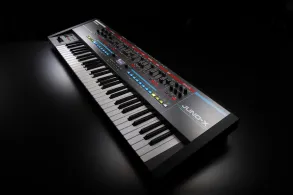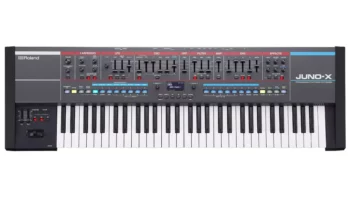New Roland Juno-X is like 3 Synths in One
Roland today introduced the JUNO-X, a new polyphonic synthesizer that they say reimagines the vintage JUNO experience with vastly expanded sound possibilities.
Roland’s early-’80s production line – think Juno-106 and Juno-60, the new Juno-X synth has classics appearance, but inside it is different.
The Juno-X features a full-fat version of Roland’s all-digital Zen-Core engine, along with emulations of both Juno-60 and Juno-106, and other Roland classics. Plus, you have the option to add more as Model Expansions, and inside the Juno-X features a full-fat version of Roland’s all-digital Zen-Core engine, along with emulations of both of those aforementioned Junos (60 and 106) and other Roland classics. Plus, you have the option to add more as Model Expansions.
Additionally, there’s an all-new Juno-X engine that features Roland’s classic Super Saw waveform, velocity sensitivity, pitch envelope controls and more. You get both of the original Juno chorus modes, too, plus a third mode that promises “even more fatness and swirl”. These modes can be combined to create a total of seven different chorus effects, any of which can be applied to any Juno-X tone.
In addition to the core Juno Models, the Juno-X features models of Roland’s PCM-based XV-5080, acoustic pianos from the RD series and a vocoder. Other models that can be added include the Jupiter-8, JD-800, SH-101 and Vocal Designer.
Juno-X provides support for Roland Cloud Connect, as well – purchase the WC-1 wireless adapter and you get a year’s Roland Cloud Pro membership included, so you can browse, audition and load Model Expansion titles and other Pro membership content directly from the Juno-X, via Wi-Fi
Up to four tones can be layered together, and a wide selection of effects are available for enhancing sounds. You also get Roland’s I-Arpeggio function – first introduced on the Jupiter-X – which delivers both traditional arpeggio patterns and others that are driven by ‘intelligent’ algorithms.
Juno-X comes equipped with a 61-note keyboard that supports aftertouch, while connectivity includes 1/4-inch headphone and L/R outputs, mic, aux and pedal inputs, standard MIDI I/O ports and USB ports for computer connection (MIDI and audio) and a flash drive.
And you get a set of built-in speakers – Bluetooth connectivity means that you can stream music through them from a mobile device – and software editing comes via the Juno-X Editor, which runs on PC and Mac.
Audio Demo:
The Roland JUNO-X available in May in US.




























